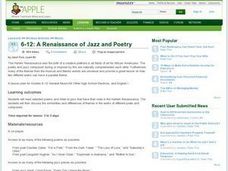Curated OER
Understanding the Music of the Civil Rights Movement
Students examine protest music and songs from the Civil Rights movement. In this music of the Civil Rights era lesson, students listen to selected music before working in groups to determine who the music was directed at, what social...
Smithsonian Institution
Black Diamond
Score a home run with this packet of information on the very first player of the Negro League to be elected into the National Baseball Hall of Fame — cultural groundbreaker and sports legend Satchel Paige. These worksheets include a...
Curated OER
Musical Roles
Learners watch a videotape on the musical career of Aretha Franklin and explore the different careers in the music industry.
Curated OER
Modern Minstrelsy: Exploring Racist Stereotypes in Literature and Life
Satires may be designed to expose a bias to ridicule but if misunderstood can they reinforce that bias? Langston Hughes poem, “Minstrel Man” opens a discussion of racist stereotypes, the minstrel tradition, and the musical, “The...
Alabama Department of Archives and History
Strange Fruit: Lynching in America
To continue their study of the Civil War, Reconstruction, and the beginning of the civil rights movement, class members watch the YouTube video of Billie Holiday singing "Strange Fruit" as an introduction to an examination of lynching in...
Curated OER
A Renaissance of Jazz and Poetry
Students explore, analyze, study and read a variety of poems and listen to jazz that have their roots in the Harlem Renaissance. They then discuss the similarities and differences of themes in the works of different poets and composers.
Curated OER
Children's March Teacher's Guide, Activity 1
Students study how political movements involve students as well as adults. They discover that students of all ages have the power to make a difference in the world.








